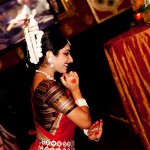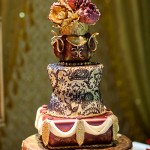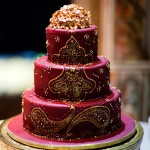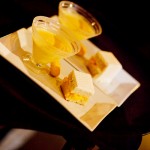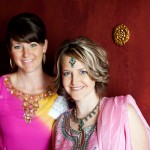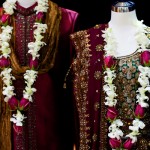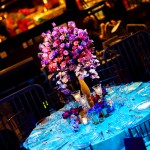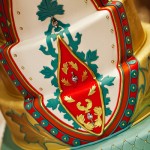The scene at House of Blues’ Foundation Room was, itself, a showcase of Indian wedding wonders, at the April 15 National Association of Catering Executives’ wedding trends luncheon. Guests got a traditional, and fragrant, Indian welcome, complete with sandalwood, rose water and kumkum (lime-treated turmeric powder), followed by plenty of time to peruse tables laid with ornate linens, spectacular mandaps (the traditional Indian-wedding canopy structure), and ornate brides’ and grooms’ outfits, all assembled in a space turned out in shades of copper, bronze, turquoise, pink and gold—magnificent!
(Photos by D. Jones Photography)
No Indian wedding would be complete without sweets and entertainment, and in these departments the NACE event did not disappoint. Guests dug into cardamom-infused wedding cake with fresh mango filling, refreshing lassi drinks and traditional Indian sweets, while enjoying live bhangra music (if bhangra doesn’t make you dance, nothing will!) and dhol drumming.
In the midst of all this spectacle and beauty, keynote speaker Radhika Day, publisher of Weddings in Houston, shared her input on hot, emerging and enduring Indian wedding trends. Here’s the scoop:
Groom’s Arrival:
The modern groom arrives in an expensive convertible, though the true traditionalist might still choose to arrive on a horse, or even an elephant or camel. At least one innovative groom arrived at his wedding on a Segway!
Ceremony:
Reform Hindu—or arya samaj—weddings are very popular. Since many brides and grooms belong to different communities from India, the arya samaj ceremony serves to satisfy both sets of families. Also, both Hindus and non-Hindus can marry in this ceremony without converting. Convenient!
Attire:
Couples today bring a mix of western and Indian elements to the wedding since many have grown up here in the U.S. Many couples are choosing to wear traditional attire for the ceremony and an ethnic outfit with a western twist for the reception.
Decor:
There is a great deal of emphasis on the decor at upscale Indian weddings. Elaborate and colorful tents and backdrops that transport guests to the grandeur of a bygone era are not uncommon.
Entertainment:
The modern Indian wedding has been greatly influenced by Bollywood and it’s not unusual for couples to bring in Indian entertainment groups to perform and get the crowds moving. Live musicians such as dhol players at the baraat, and DJs, bands and professional dancers at the reception, are not uncommon.
Wedding Planners:
Every Indian family has older traditional relatives who actually guide the wedding couple on religious rituals and expectations. What couples need a planner for is to keep the crowds organized and to coordinate the many vendors involved in the wedding. Many young couples do not necessarily seek out an Indian wedding planner but look for someone who will help tie eastern and western elements together.
Food:
Often, the Indian wedding guest list includes a mix of Indian and non-Indian guests. Expect large, overflowing multi-cuisine buffets and multiple food stations with many dishes (yum!). Since the traditional Indian wedding involves so many events with the same guest list, most families like to vary the cuisine at the different events. A wedding cake—though not an Indian tradition—usually is part of the reception, and is served in addition to Indian desserts and sweets. Often the cake flavors, fillings and decoration will have an Indian twist. And, for drinks, signature cocktails using mango or litchi are quite popular. Bottoms up!
Special thanks to Steve Lee, Ky Signature, Luxe Studios, Studio Capture, J. Cogliandro for allowing the use of their beautiful images in the Experience the Mystique of India presentation.


